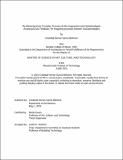Re-Alimentaciones-Cruzadas: Procesos de Re-imaginación entre Epistemologías Acústicas/Cross-Feedback: Re-Imagining processes between Acoustemologies
Author(s)
García Belmont, Cristóbal Herman
DownloadThesis PDF (3.347Mb)
Advisor
Green, Renée
Terms of use
Metadata
Show full item recordAbstract
This compilation of texts actively revisits and develops poetical mythologies through notions of reverberation and feedback to transcend juxtapositions. Re-imagining two mythological snakes, the Amphisbaena, and the Ouroboros, the reader is invited to revalue their placement in intricate post-colonial realities by imagining metaphysical circuits connecting different spaces and times. The work presents a series of contrasting essays reflecting the mouths and body of the Amphisbaena, the two-headed snake. The first essay focuses on the littoral region of Perú during the transition from a viceroyalty into a republican state. Here we find a shapeshifting musical tradition engaging with percussive idiophonic—or self-resonating— instruments. Traditions get confined into the visual realm to capture a new multicultural identity. Lost in transduction, how, via sound, does one create circuits which transform bodies, space, and time through reverberation? The second essay narrates the history of acoustic feedback as the birth of an ouroboric, selfeating cycle. By deconstructing/reconstructing a series of artworks, the text becomes a tale of metamorphosis of the ouroboros, getting into notions of active practice, later into an amphisbaena regarding notions of material resonance, and finally into concrete poetry in the processes of analyzing the development of consciousness around the artwork. The work ties two sonic practices from different times, cultures, and locations by building sculptural self-resonators activated by auditory feedback. The repercussions of transforming spatial configurations via sound prove that sonic practices can alter how we approach our nomadic circulations. The sound created by contrasts blurs the borders of sense and perception, giving us a space for subjective interpretation and leading to new imaginaries. This work reflects sonic feedback—dichotomous diaphragms, some idiophonic, some membranous, that have learned via the artwork to resonate together, accentuating relations, creating circuits, and shortening distances that once seemed far away.
Date issued
2023-06Department
Massachusetts Institute of Technology. Department of ArchitecturePublisher
Massachusetts Institute of Technology